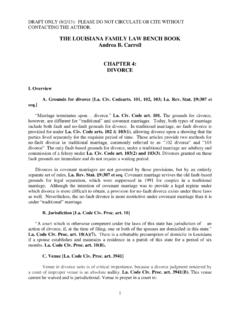Transcription of Gwen’s Law: Bail Hearings in Felony Domestic Abuse Cases
1 Gwen s Law: bail Hearings in Felony Domestic Abuse Cases Panelists: Judge Scott Gardner 22nd Judicial District Court Margaret Hay Assistant District Attorney, 24th Judicial District Court Tommy Clark Grambling City Chief of Police Taylor Townsend Kelly & Townsend LLC 2015 Evidence and Procedure Seminar LOUISIANA JUDICIAL COLLEGE LOUISIANA ASSOCIATION FOR JUSTICE February 27, 2015 * Windsor Court Hotel * New Orleans, Louisiana Act 318 Hearings in Domestic Abuse Cases Chief Tommy Clark, Chief of Police, City of Grambling Margaret Hay, Chief of Family Violence Unit, Jefferson Parish District Attorney s office T. Taylor Townsend, Attorney at Law Scott Gardner, District Judge, 22nd Judicial District Court Overview The traditional purpose of bail is to guarantee the appearance of the accused.
2 The traditional purpose of pretrial detention is to protect victims, their families, witnesses and the public from the potential future actions of the arrestee. Studies show that lethality is often highest surrounding victims efforts to separate from an abuser. Couched against this backdrop, the legislature enacted Gwen s law to create a new process for bond setting in Felony Domestic violence Cases . A. The Issues Presented which led up to the Act 318 legislation 1. Lethality occurs in a small percentage of Domestic violence Cases . 2. Courts routinely must set bond on an enormous number and variety of Cases while at the same time dealing with docket pressure, time constraints and physical space limitations.
3 3. Bond is often set very early in the process of case investigation, and has often occurred before any attorney contact with victims, offenders, law enforcement and experts. 4. Victims are not the equivalent of clients or parties in other court contexts. The victims are often the best source of information about risk and lethality for the courts. Studies show that Domestic violence victims are very accurate reporters of risk and lethality indicators. However, victims often underestimate their own risk. 5. Domestic violence Cases , and victims, are subject to a dynamic and unpredictable cycle of offenses, complaints and recantation or retraction of charges. Often the families or dating partners both have a history of previous violence upon each other and other third parties.
4 6. Courts must do their best to determine whether recantation or retraction is due to fear or threats, financial or family pressures, or manipulation of the criminal justice system for other reasons. Courts must recognize that a request by a victim to drop or modify a no contact order, to release the offender, or to dismiss the prosecution may be a legitimate and valid assessment by the victims that their situation is actually more dangerous with prosecution of the offense. B. Generally Accepted Best Practices 1. Victim safety should be a primary consideration in whether a court should deny, or condition bond in Domestic violence Cases . 2. Courts should strive to create conditions that encourage meaningful input and exchange between the victims and fact-finders.
5 Ideally this involves victim advocates, family and friends and community resources; courts should provide a private and safe location in the courthouse for parties to speak to one another. 3. Courts should recognize that validated lethality assessments represent an important tool in denying or setting bond and in imposing or modifying conditions. Although conducting lethality assessments so early in the process creates logistical, financial and time pressures on the court system, risk assessments remain a much more reliable predictor of future violence and witness intimidation than p rofessional ju dgment or the victims subjective wishes. Some validated risk assessment tools are designed to be used by law enforcement.
6 4. Courts must recognize that for a substantial number of victims, the ideal result is elimination of the violence while maintaining the relationship. C. The Unexpected: Law enforcement officers in the field have embraced the opportunity 1. Law enforcement officers often have a history with the victim and defendant. 2. Law enforcement can document the situation in the heat of the moment . 3. As a result of their experience with the parties, law enforcement officers can give guidance to courts on danger, lethality and the particular situation at hand. Many officers in the field welcome the opportunity to have meaningful input into critical stages of the prosecution such as bond setting.
7 D. Act 318 as enacted 1. Allows for detention without bond for up to 5 days exclusive of weekends and holidays for any Felony arrest involving family or household members, or dating partners. 2. A contradictory bail Hearings must be held. 3. A mandatory risk assessment must be conducted by the court including various factors. 4. A court may deny bond, or grant bond with or without conditions, and order registry with the LPOR. E. Current Issues in Implementation and Protocols which have been effective 1. Time constraints and physical constraints, especially in multi parish jurisdictions. 2. Access to risk assessment professionals, training and materials. 3. Service of process on the victim and law enforcement for Act 318 Hearings within such a short time frame.
8 4. All of which are compounded by the scope of the statutes. F. Discussion of Proposals for the 2015 session I2J456789l0llt2t3t4l5l6t7l8l920 HLS 14RS-249 IORIGINALR egular Session, 2014 HOUSE BILL NO. I I42BY REPRESENTATIVE BURRELLCRIMINAL/ bail : Provides relative to bail restrictions for offenses against a family orhousehold member or dating partnerANACTTo amend and reenact l4:79(A)(l)(a) and (E), a6 (B), and Code ofCriminal Procedure Article (A)(1), relative to bail ; to provide relative to bailrestrictions for offenses against a family or household member or dating partner; toprovide for the issuance of a Uniform Abuse Prevention Order; to provide relativeto the possession of f rearms by persons subject to the order; to provide for theinclusion of such orders in the Louisiana Protective Order Registry; and to providefor related it enacted by the Legislature of Louisiana:Section l.
9 Code of criminal Procedure Article (A)(l) is hereby amended andreenacted to read as follows:Art. Offenses against a family or household member or dating partner;provisions for forfeiture, arrest, modificationA.(lX In determining conditions of release of a defendant who is allegedto have committed an offense against the defendant's family or household member,as def ned in 46:2132(4),or against the defendant's dating partner, as definedin 46:2151, or who is alleged to have committed the offense of Domestic abusebattery under the provisions l4 , or who is alleged to have committed theoffense of stalking under the provisions of 14 , the court shall considerwhether the defendant poses a threat or danger to the victim. If the court determinesPage I of5 CODING: Words in stn:clcthrough type are deletions fiom existing law; words underscoredare I4RS-249I ORIGINALHB NO.)
10 Ll42that the defendant poses such a th eat or danger, it shall require as a condition ofbailthat the defendant refrain from going to the residence or household of the victim, thevictim's school, and the victim's place of employment or otherwise contacting thevictim in any manner whatsoever, and shall refrain from having any further contactwith the ) If. as pat of a bail restriction. an order is issued pursuant to theprovisions ofthis Paraeraph. the iudge shall cause to have preoared a Uniform AbusePrevention Order. as orovided in 46 shall sien such order. and shallimmediately forward it to the clerk of court for filine. on the day that the order isissued. The clerk of the issuine court shall transmit the Uniform Abuse PreventionOrder to the Judicial Administrator's OfI ce.









